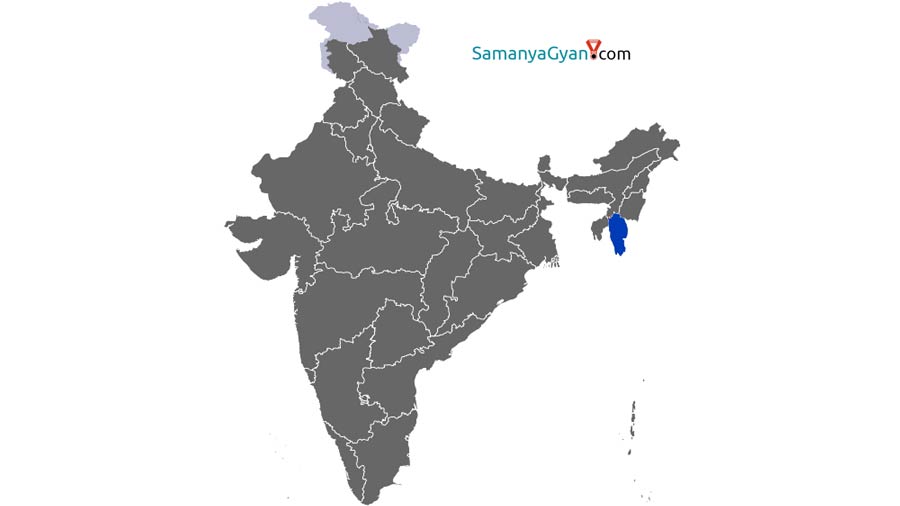Through this chapter, we will know the detailed and important information of Mizoram, in which important and interesting information like history, geography, economy, education, culture and world famous tourist places located in the state have been added. Apart from this, the recent developments and changes in the state of Mizoram have also been explained in detail. This chapter is full of interesting facts for the competitive aspirants as well as the readers.
Quick General Knowledge
| State Level | State |
| Capital | Aizawl |
| Statehood | 20 February 1987 |
| Largest City | Aizawl |
| Total Area | 21,081 sq km |
| Districts | 8 |
| Current Chief Minister | Zoramthanga |
| Current Governor | Dr. Kambhampati Haribabu |
| State Bird | Mrs. Humes pheasant |
| State Flower | Renanthera imschootiana |
| State Animal | Sumatran serow |
| State Tree | Mesua ferrea |
| Languages | Mizo, English |
| State Dance | Cheraw Dance, Khuallam, Chailam, Sawlakin, Chawnglaizawn, Zangtalam, Par Lam, Sarlamkai/ Solakia, Tlanglam, Khanatm, Pakhupila, Cherokan |
Mizoram (मिजोरम)
Mizoram is a state located in the northeast of the country. Aizawl is the capital of Mizoram and the largest city in the state. The state is situated from Bangladesh in the west, Myanmar in the east and south, Manipur in the north, Assam and Tripura. Mizoram is a mountainous region. The state of Mizoram is also known as the "Song Bird of the East".
The government of Mizoram, like any other state in the country, is made up of executive, legislative and judiciary. The executive branch of the state is headed by the governor. The head of the state, like other states, is the governor. Mizoram has 40 assembly constituencies and 01 parliamentary constituency.
The major political parties of the state are Maramaland Democratic Front, Mizo National Front, Mizoram People's Conference, Zoram Nationalist Party, Bharatiya Janata Party (BJP) and Indian National Congress.
The state currently has a government of the Indian National Congress. The current Chief Minister of Mizoram is Zoramthanga. The first person to become the Chief Minister of Mizoram, L.S. It was healing He was sworn in as Chief Minister of the state on 03 May 1972.
The present Governor of Mizoram, Dr. Hari Babu Kambhampati. Dr. Hari Babu Kambhampati is sworn in as the Governor of Mizoram on 25 October 2019.
Several types of mineral substances are also found in the state, which mainly consist of sandstone and clayey sandstone, siltstone, shale, greywacke and mudstone.
The people of Mizoram are mainly engaged in silk industry, producing mulberry, eri, coral and tussar silk. Small scale industries of the state mainly include sham industry, handloom and handicrafts industry, sawmills and furniture factories, oil refining, grain milling and ginger processing industries.
The state of Mizoram is very much ahead in music and culture, people here love music very much. The people of the state play drums called khong which are made of wood and animal fat. The main popular dance forms of Mizoram include Charo, Chheh Lam and Khullam. People here attract people to them with simple, beautiful, colorful and beautiful designs.
The most common and favorite traditional dress of women in Mizoram is the Pujan Mizo.
There are a total of 08 districts in the state of Mizoram, Aizawl is the largest district in the state by population, with a population of 400309. Mizoram has the following 08 districts: - Aizawl, Champhai, Kolasib, Longlatai, Lunglei, Mamit, Syah and Serchhip.
- In FY21, the annual allocation in Mizoram to implement the ‘National Bamboo Mission’ stood at Rs. 70 million.
- In Mizoram improving road, rail and air connectivity and the establishment of trade routes with neighboring countries, trade facilitation has improved over the last decade.
- Bamboo forests cover 3,267 sq kms of Mizoram’s geographical area. There is an estimated growing stock of 25.26 million metric tonnes (MMT) of 35 varieties of bamboo in the state.
- The climatic conditions in the state provide a conducive breeding ground for the commercial exploitation of all kinds of silkworms. Sericulture remains one of the state's key industries. Raw silk production in Mizoram stood at 104 metric tonnes in 2019-20.
- Mizoram has the potential to generate 4,500 megawatt (MW) of hydro power. As of April 2021, Mizoram had a total installed power-generation capacity of 207.45 MW, comprising hydro (97.94 MW), thermal (71.51 MW) and renewable energy sources (38.00 MW).
- Natural resources, climatic conditions, and policy incentives in the state support investment in bamboo, sericulture, tourism, agro-products and agro-processing sectors.
Mizoram FAQs:
The capital of Mizoram is Aizawl.
The current Chief Minister of Mizoram is Zoramthanga and the current Governor is Dr. Kambhampati Haribabu.
Cheraw Dance, Khuallam, Chailam, Sawlakin, Chawnglaizawn, Zangtalam, Par Lam, Sarlamkai/ Solakia, Tlanglam, Khanatm, Pakhupila, Cherokan is the main folk dance of Mizoram.
The official language of Mizoram is Mizo, English.
The state animal of Mizoram is Sumatran serow and the state bird is Mrs. Humes pheasant.
Mizoram has a state flower Renanthera imschootiana and a state tree Mesua ferrea.
The largest city in Mizoram is Aizawl.
Mizoram is spread over an area of 21,081 sq km with the total of districts.
Mizoram state was established on 20 February 1987, after which Mizoram got the status of a separate state of India.

